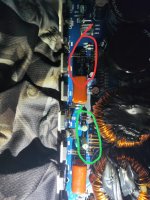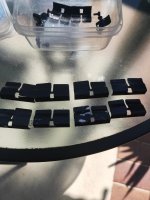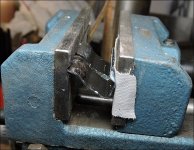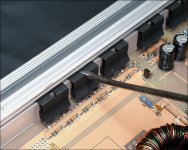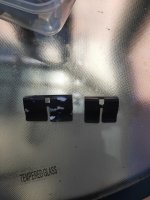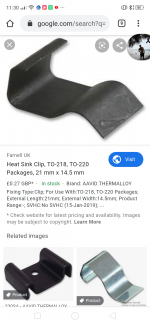Is the 'resistor on the other side' serving the same purpose? Is it within tolerance?
I can't say more about the inductors than I already have with the limited information I have to work with.
I can't say more about the inductors than I already have with the limited information I have to work with.
Is the 'resistor on the other side' serving the same purpose? Is it within tolerance?
I can't say more about the inductors than I already have with the limited information I have to work with.
HI yes i took one side out of the pcb to test it. It checks out at 24k ohms which is correct. But that one does not get hot at all.
I'm not sure if it's related but I found one other resistor that had a leg broken off. I'm not sure on the purpose of it but it's a 22ohm resistor. I got a replacemt but it's a bit smaller. I might just try get the right size resistor no point soldering twice.
Green are all the same and the red circle is where I removed the broken resistor.
And I really appreciate you're help I know u don't have much to go on. I'm just not 100% clued on to how these things work. And why things are getting hot. It's definitely not normal as you could smell the burning.
Attachments
How do you know it's not normal to get hot?
If it's connected across the rail/rail caps, it's going to get hot. Simply touching it could make it have an odor when it heats up. Dust on it can make it smell.
Contact Lanzar tomorrow to see if you can get a diagram.
If it's connected across the rail/rail caps, it's going to get hot. Simply touching it could make it have an odor when it heats up. Dust on it can make it smell.
Contact Lanzar tomorrow to see if you can get a diagram.
The other amp I have here same model stays nice and cool. As with the opposite side of the faulty amp that resistor stays nice and cool. And it's doing the same thing. I'm not sure exactly what model lanzar it is it's in a US audio bonecrusher case I just noticed a guy on YouTube fixing the exact same board and it was a lanzar opti 7k apparently.How do you know it's not normal to get hot?
If it's connected across the rail/rail caps, it's going to get hot. Simply touching it could make it have an odor when it heats up. Dust on it can make it smell.
Contact Lanzar tomorrow to see if you can get a diagram.
I've tried to contact the US audio supplier here in Australia for other models of there amps and they are not at all helpful
Do you not have a scope to check your oscillation frequency?
I have an old handheld scope I can see the waveform however it's frequency is somewhat not calibrated as it's old. I got a nice square wave but when I looked at frequency it said 185k. I tested the high side and low side all checked out fine. On the waveform.
I think I found the issue there was a snapped leg on a resistor. Only issue now is trying to find the mosfet spring clamps I bent the original ones pretty bad. I'd rather not use them. But I can't find replacemts I called the supplier here in Australia that repairs these amps but they won't sell the clips to the public 🤔
Post a photo of the damaged clamps.
If you still feel there is a problem, confirm that both amps are operating at approximately the same frequency.
If you still feel there is a problem, confirm that both amps are operating at approximately the same frequency.
These are the worst. They hold down the output fets. The rest can be salvaged and bent back to work okPost a photo of the damaged clamps.
If you still feel there is a problem, confirm that both amps are operating at approximately the same frequency.
Attachments
If you have no other choice, you can straighten the tabs with two pairs of pliers. You can reset the tension in a vise (below).
To remove them with little chance of doing damage, you need a tool that can go into the notch and bent the tab to let it come out of the slot. Using a tool like the one below, you simply push down on the screwdriver handle and the clip pops off. A cotter key remover also works well, even better with a modification.
To remove them with little chance of doing damage, you need a tool that can go into the notch and bent the tab to let it come out of the slot. Using a tool like the one below, you simply push down on the screwdriver handle and the clip pops off. A cotter key remover also works well, even better with a modification.
Attachments
If you have no other choice, you can straighten the tabs with two pairs of pliers. You can reset the tension in a vise (below).
To remove them with little chance of doing damage, you need a tool that can go into the notch and bent the tab to let it come out of the slot. Using a tool like the one below, you simply push down on the screwdriver handle and the clip pops off. A cotter key remover also works well, even better with a modification.
Ah yes I did that with a previous amp I repaired. I know I can bend them back however 2 of them are cracked so not so confident that they will push the mosfets against the heat sink with enough pressure to disapate heat properly.
I mean at this stage I don't really have any other option other than to use the old clips.
I just sent an email to the company that repairs these hopefully the email will go to a different person than I spoke to on the phone and they can organize to sell me a few. Or possibly they have one of these amps that is buggered and I can buy that for parts.
So silly if you ask me. Not selling parts to the public. They are only pieces of metal....
I don't know how old you are but I can tell you that after dealing with the general public for MANY years, something like this isn't worth the trouble. Some people/transactions may be smooth but many will not. Some companies will sell parts but not many. I think Power Acoustik is one of the few but I don't know if that's still true.
If the clips are all the same, use the weak ones in the rectifiers or regulators.
Another option (generally only for TO-220 semis) is the AAVID Thermalloy 4525.
https://www.newark.com/aavid-thermalloy/4525/heat-sink-to-220/dp/02M0324
These are typically disposable and have to be trashed if removed.
If the clips are all the same, use the weak ones in the rectifiers or regulators.
Another option (generally only for TO-220 semis) is the AAVID Thermalloy 4525.
https://www.newark.com/aavid-thermalloy/4525/heat-sink-to-220/dp/02M0324
These are typically disposable and have to be trashed if removed.
38n30. They are bigger than the rectifiersI don't know how old you are but I can tell you that after dealing with the general public for MANY years, something like this isn't worth the trouble. Some people/transactions may be smooth but many will not. Some companies will sell parts but not many. I think Power Acoustik is one of the few but I don't know if that's still true.
If the clips are all the same, use the weak ones in the rectifiers or regulators.
Another option (generally only for TO-220 semis) is the AAVID Thermalloy 4525.
https://www.newark.com/aavid-thermalloy/4525/heat-sink-to-220/dp/02M0324
These are typically disposable and have to be trashed if removed.
That website you sent just sends me to there homepage? Is there anywhere that sell these clamps with fast international shipping? I'm pretty sure there the same in the dd z1a.
Attachments
Did you search for the part number from the home page?
Someone may post a source for the parts you want so give it a couple of days before ordering.
Someone may post a source for the parts you want so give it a couple of days before ordering.
Did you search for the part number from the home page?
Someone may post a source for the parts you want so give it a couple of days before ordering.
These ones are about 20mm from top to bottom and about 10mm depth (From where it sits out of the hearsink) I had a look at that site you sent they look like they may work but they had another on there I noticed. Not sure if they ship to Australia? I had a bit of a look around at other sites but no luck
Attachments
Is there a difference between carbon film and wire wound cement type resistors? As the one that broke is a carbon film type (round) and I can only get the big 5w cement style as a replacemt. The 1w are too small and get too hot.
If it's OK I plan on swapping them all out for the large square type as they are a higher wattage and will disapate heat better
If it's OK I plan on swapping them all out for the large square type as they are a higher wattage and will disapate heat better
Attachments
Too hot?
It depends on the application.
Resistors dissipate heat. Larger resistors are used for applications where they generate a lot of heat. Just because a resistor gets hot doesn't mean that there is a problem. The manufacturers aren't perfect but they test and get most parts right.
It depends on the application.
Resistors dissipate heat. Larger resistors are used for applications where they generate a lot of heat. Just because a resistor gets hot doesn't mean that there is a problem. The manufacturers aren't perfect but they test and get most parts right.
Too hot?
It depends on the application.
Resistors dissipate heat. Larger resistors are used for applications where they generate a lot of heat. Just because a resistor gets hot doesn't mean that there is a problem. The manufacturers aren't perfect but they test and get most parts right.
Well I can't get a 3w resistor and I'm pretty sure that's the size that broke. I can only get 1w and 5w. I put a 1w in for quick test but it got quiet hot. A lot hotter than the other 3. I'm pretty sure they run the fets. 1 resistor per bank of 4. I'm not sure on the exact purpose but I need to replace atlest 1 of them as the leg was broken. Would it be safe to use the white square resistor as a replacemt? Should I replace the other 3 to the 5w version just to keep it all the same or safe to just replace the 1?
Why can't you order the right part. Does is have to be repaired ASAP?
In many circuits, using a higher wattage resistor of the correct value is acceptable but in some circuits, the resistor size is used to offer a level of protection to the other components. I don't know how this one is being used.
Did you do some research to find the exact Lanzar model and try to get the diagram from Lanzar?
In many circuits, using a higher wattage resistor of the correct value is acceptable but in some circuits, the resistor size is used to offer a level of protection to the other components. I don't know how this one is being used.
Did you do some research to find the exact Lanzar model and try to get the diagram from Lanzar?
I'm just not sure on the exact size wattage of the old resistor so if I look online it was a bit confusing. So I just went down to my local electronics store and got what they had. Which was a 1w and a 5w. By looking at them the old one looks to be a 3w. I'm just not sure
Edit.
I can not find a sutible replacement resistor in Australia. Other than the wire wound which I already got. The only difference between carbon and wire wound is apparently wire wound is not so good at high frequency circuits.
Short of buying from China which is the only place I can find the correct carbon resistor.
My theory here is bigger can only be better. The company may have used these to cut cost. But the last thing I want to do it blow this amp up due to the wrong components.
Edit.
I can not find a sutible replacement resistor in Australia. Other than the wire wound which I already got. The only difference between carbon and wire wound is apparently wire wound is not so good at high frequency circuits.
Short of buying from China which is the only place I can find the correct carbon resistor.
My theory here is bigger can only be better. The company may have used these to cut cost. But the last thing I want to do it blow this amp up due to the wrong components.
Last edited:
- Home
- General Interest
- Car Audio
- Class d amp repair help.
